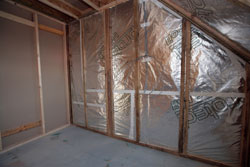Glidevale Protects Homes for the Future
A pilot scheme to demonstrate how energy-efficient design will play a role in social housing for the future has opened its doors in Glasgow – with protection from Glidevale.

The Glasgow House is a partnership between Glasgow Housing Association, PRP Architects and City Building to demonstrate how different build types can achieve high levels of insulation and low running costs.
Four prototype homes have been built, using two different construction techniques – two with thin bed insulating hollow clay blocks and two with timber frames. The homes will have their energy usage monitored over a period of time to calculate their energy efficiency.
Each of the timber frame properties features Glidevale’s innovative Protect TF200 Thermo reflective breather membrane and VC Foil low emissivity vapour control layer in the roofs and walls. The combination ensures optimum warmth is retained within the structure, air leakage is minimised, yet internal moisture vapour is ventilated out to atmosphere, minimising the risk of potential damp and condensation.
Bryan Galloway, head of new build housing at City Building, one of Scotland’s largest construction companies and which built The Glasgow House, said: “At City Building, sustainability is at the heart of everything we do. The Glasgow House is an exciting project, which has huge potential to shape design and housebuilding practice in the future. It will be interesting to see how the different construction types compare over the years, as we continue to appraise energy performance.”
The timber frame homes have been factory built by City Building’s apprentices, and are delivering U values of 0.15w/m²K for the walls and 0.13W/m²K for the roofs, plus airtightness in line with the stricter requirements of the new Approved Document L. The timber frames for the two homes were made by Europe’s largest assisted workshop facility, Rotal Strathclyde Blindcraft Industries (Blindcraft), which is operated by City Building and employs over 250 people, more than 50% of whom have a disability.
Glidevale’s Protect TF200 Thermo provides 0.77m²/KW thermal resistance, a 327% thermal resistance improvement over a standard unventilated airspace of 20mm or more. It has a water vapour resistance of 0.55MNs/g, which meets the requirements of NHBC, TRADA and BS5250. Protect TF200 Thermo also provides a second line of defence against water penetration during the construction phase. Protect VC Foil installed in timber frame walls facing a 20mm still airspace, gives an equivalent thermal performance to at least 34mm of mineral wool, helping to achieve the required U value with a lesser thickness of insulation. This also has the benefit of creating a service cavity on the warm side of the insulation helping to maintain the integrity of the vapour control layer.
Both membranes are designed to optimise heat retention within the structure whilst bringing air leakage to ‘best practice’ levels of 3m³/hr/m² or below. The comprehensive range includes a package of tapes designed to seal lap and butt joints, as well as nail and service penetrations which ensure the BuildTight range meets current and future building standards of airtightness.
Ends
Article supplied by AFPR on behalf of:
Glidevale Ltd
Tel: 0161 905 5700
Email: abigailg@buildingproductdesign.com
Web: http://www.glidevale.com
